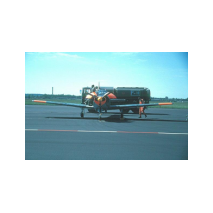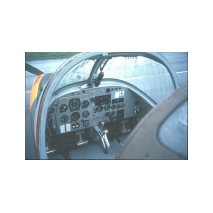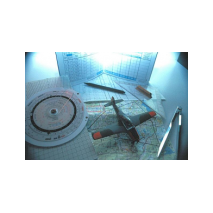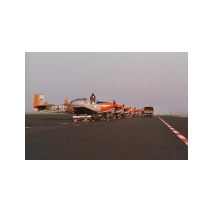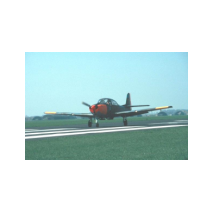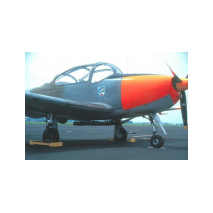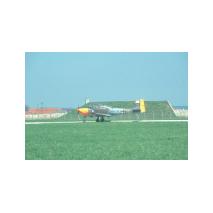P-149-D
My first Solo on the Piaggio P-149-D
11.06.1987 with aircraft 91+51.
During your ground training you will be briefed on all emergency procedures and before you fly solo, you will write an emergency procedure test. This test covers all possible malfunctions and mishaps which may occur during your first solo flight. If you know your emergency procedures, especially the "BOLD FACE PROCEDURES", and use some common sense, you will easily pass this test. The minimum passing grade is 75%. The test is also failed, if one or more bold face procedure are answered incorrectly or incomplete. For your convenience, you may study the correct answers from the following pages. During your solo flight you may encounter one of the following problems:
1. What are the four basic rules that you have to follow, if you encounter any problem or emergency during flight?
Maintain aircraft control,
Analyze situation and take proper action
Land as soon as possible / practicable
Inform tower
2. After your instructor has left the aircraft, you want to start up the engine again. While you press the starter button, you suddenly observe smoke coming out of the cowling and the technician gives you the shutdown signal. What do you suspect, and how do you react?
Engine fire during starting Reaction:
1. Fuel shutoff knob - out
2. Fuel pump - off
3. Battery SW - off
4. Aircraft - abandon
3. During solo Flight your engine fails on down wind. What will be your reaction?
Airstart
1. Fuel pump - on
2. Tanks - change
3. Carburetor heat control - warm
4. Glide - 90 KIAS
4. Standing in No. 1 position, you call tower for T/0 clearance, but you get no answer. After rechecking the radio switches and trying all possible frequencies, you are sure that the radio has failed.
Wait for a flashing white lightgun signal from tower, Taxy back to the ramp and shut down engine.
5. On takeoff you have accelerated to 50 KIAS, Suddenly the engine quits with loud noises. What is your reaction?
Abort:
1. Throttle - idle
2. Brakes - apply as necessary
3. Engine - shutdown
4. Then inform tower and complete the engine shutdown checklist
6. After being safely airborne with your Piaggio, you want to raise the gear, but it does not come up. What do you do?
1. Gear switch down again
2. Check safe gear down indication
3. Fly a normal pattern, inform tower and perform a full stop landing.
7. After takeoff you have just raised the gear, as the engine suddenly stops with loud banging noises. What is your reaction?
Lower nose immediately and fly straight ahead maintaining safe airspeed (slight directional changes are possible, if altitude and speed permit)
1. Fuel shutoff knob - out
2. Ignition - off
3. Stopcock - out
4. All circuit breakers - off
8. During the after take off checks you switch off the fuel pump. While you check the fuel pressure indication, the pointer starts to drop 0.8, 0.7, 0.6, and so on. What do you dou?
Switch electrical fuel pump on. Inform tower. Perform full stop landing out of a normal pattern.
9. You fly your first solo on a cold and moist winter day. On crosswind leg the engine starts to become rough, RPM fluctuates and manifold pressure decreases although you have full power. What do you suspect and what is your reaction?
Carburetor icing:
1. Pull carburetor heat control
2. Inform tower and perform full stop landing out of a normal pattern.
10. Before turning to downwind you are distracted by another aircraft performing some wild maneuvers in front of you. As you try to reorient yourself, you can not find the usual landmarks anymore. Getting nervous, you change the heading several times trying to find the field again. Finally you have to admit, that you have lost the orientation. What should you do?
1. Ask tower for assistance (DF steer)
2. Follow the instructions given by tower until you come overhead the field again.
11. You taxy out for RWY 09 on a hot summer day for your third solo pattern. All of a sudden you see, that the fire warning light is on. What is your reaction?
Although it may be just a false indication or the cowlflaps are still closed, you have to suspect engine fire, so:
Stop the aircraft
1. Fuel shutoff knob - out
2. Fuel pump - off
3. Battery Switch - off
4. Leave aircraft as soon as possible
12. As you just start the turn onto downwind leg during your solo flight, the engine fails your airstart was unsuccessful. What do you do?
Perform Forced Landing
1. Shoulderharness - lock
2. Gear - up
3. Select landing field
4. Call MAYDAY
5. Glide 90 KIAS
6. Fuel shutoff knob - out
7. Ignition switch - off
8. Stopcock - out
9. All circuit breakers - off
10. After touch down jettison canopy
13. Flying on downwind leg during your solo flight, the generator warning light comes on. What do you do?
1. Check voltmeter reading
2. Perform full stop landing
If battery voltage is down already, you may have to lower the gear mechanically and wait for a light signal from tower.
14. Flying on downwind leg, you observe the RPM dropping back to 2500 and the oil pressure to zero. What is your reaction?
Inform tower
If close enough, perform forced landing at the airfield.
If too far out, perform forced landing at the nearest usable field.
15. Flying on downwind leg, you see the fire warning light coming on. There are no other indications of fire. What is your reaction?
Make sure the engine instruments show normal indications.
Check cowl flap handle out
If there are still no other indications of fire:
Inform tower and perform a full stop landing
If an actual fire is confirmed:
1. Fuel shutoff knob - out
2. Prepare forced landing or bail out.
16. As you cruise along on downwind leg, you want to check the speed. To your surprise, the pointer is at the zero detent, although the power setting and aircraft attitude are perfectly normal. What do you do?
1. Switch pitot heat - on
2. Inform tower
3. Maintain normal power setting and level flight
If indication does not come back (ice):
Stay at 1000 ft AGL in the pattern
Follow instructions given by the tower.
17. Opposite tower you try to lower your landing gear and get an usafe gear indication. Although you try it two more times, the gear indication is still unsafe. What do you do?
Inform tower
Fly the pattern ground track but stay at 1000 ft AGL
Refer to checklist for landing gear emergency extension.
Follow instructions given by the tower.
18. You happen to fly the first solo mission during the bird migration season. Flying on downwind leg, a large bird hite the left wing of your aircraft and leaves a big hole in the leading edge. The aircraft is still controllable. - What do you do?
Inform tower
Stay at 1000 ft AGL in the pattern
Follow instructions given by the tower.
19. After rolling out on base leg you make the base leg call but there is no answer. You try it two more times and still get no reply. What is your reaction?
Perform a low approach
Try to contact tower on UHF CH 2/12 or VHF CH B/D
If no contact:
Perform a normal approach
Wait for green light from tower
20. You had been cleared for landing by tower on base leg and now you turn to final. All of a sudden you observe a red flare or lightgun signal. What do you do?
Go around
Fly a normal pattern and ask for landing clearance on base again.
21. Runway in use at Fuersty is 27 right. Due to a slight tailwind or because you took the key point too late, you land long. As you approach the second taxiway intersection and you are ctill too fast to turn off, and consequently have to go straight aheed. How do you get back to the normal taxiway?
Continue to the end of 'runway 27 right and take the last intersection to the left. Request clearance for backtrack on the runway from tower.
22. Due to a long landing you want to use the brakes to make the turnoff to the taxiway. As you step into the pedals there is no reaction. What do you do?
Shutdown the engine on the runway to come to a stop. Inform tower that you have shutdown the engine on the runway due to brake failure. Continue engine shut down due to checklist.
23. After your second landing you taxi clear of the runway and start to perform the after landing check. As you switch off the fuel pump, the engine suddenly stops. What do you do?
1. Inform tower
2. Wait for the ground crew to standby with a fire extinguisher
3. Restart the engine according to checklist.
24. On base leg during solo flight you recognize a radio failure. What is your action?
Continue approach, watching for green light given by the tower.
If no light signal received, perform go around,
fly a normal pattern, start another approach,
and check tower again for a lightgun signal.
25. During take off roll you observe while checking take off power an indication of 0,75 ata only. What do you do?
Engine failure procedures
1. Throttle - idle
2. Brakes - apply
3. Tower - inform
The mimum passing grade for this test is 75%. The test is also failed, if one or more bold face procedures are answered incorrectly. On question equals 4,0%.
1. State total fuel capacity: 236 liter
state the total usable fuel: 230 liter
2. State average fuel consumption at normal cruise: 57,5 liter/hr
3. State the maximum allowable gross weight for
cruise flight: 1820 kp
acrobatic flight: 1470 kp
4. State the maximum allowable airspeed for
gross weight 1820 kp : 172 KIAS
gross weight 1470 kp : 204 KIAS
5. State airspeed and power setting for the following maneuvers:
Take off:
60 KIAS
3400 RPM
Full Power
Normal cruise:
120 KIAS
2750 RPM
0.72 ata
6.State the maximum permissible crosswind component for
takeoff and landing: 20 kts
7. Landing gear warning (horn and light) comes on when:
Throttle retarted below 0.3 ata and gear is up or unsafe.
8. State the minimum altitudes for the following maneuvers:
Slow flight
Practice stalls
Simulated forced Ldg.(area)
Acrobatics
Spin entry
Spin recovery (completed)
Bail out
3000 ft AGL
3000 ft AGL
500 ft AGL
3000 ft AGL
7000 ft AGL
5000 ft AGL
3000 ft AGL
9. State the IAS on final approach: from 80 to 85 KIAS
10. State the maximum allowable IAS for various configurations:
Flaps extended REST 2
Flaps extended REST 5
Gear extension
Gear extended
113 KIAS
95 KIAS
108 KIAS
113 KIAS
11. State maximum allowable RPM when oil temperature is below 50° C: 1500 RPM
12. State maximum allowable RPM drop during mag check: 150 RPM and diffenrence between mag 1 and 2 - 30 RPM
13. The engine is started on mag 1. State the reason: snapper and ignition retarted
14. Why is the engine started on the left hand tank?
Carburator overflow is led into L/H tank
15. State voltmeter indication if the generator fails Battery voltage of 24 V
16. Carburetor icing is indicated by: Rough running engine, flactuating RPM, decrease of manifold pressure
17. State stalling speed:
Gross weight 1560 kp,
flaps rest 5,
gear down,
throttle idle 48 KIAS
18. State the G -limitation for a gross weight of 1820 kp: + 4 G
- 2 G
19. To achieve maximum gliding distance (dead engine) state:
IAS:
Configuration:
90 KIAS
gear and flaps up
20. The following three maneuvers are prohibited: Whip stall, inverted flight, forward loop
I certify that I have answered these questions by my own and that I was made familiar with all flying safety regulations and with all emergency procedures concerned.

